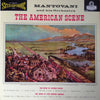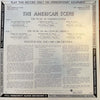











Mantovani And His Orchestra – The American Scene
Rarity - Sealed
Annunzio Mantovani's orchestra
Conducted by Annunzio Mantovani
Arranged by Annunzio Mantovani (A3, A6, B1-2, B4), Cecil Milner (A1-2, A4-5, B5), Don George (B3)
Written by Stephen Foster (A1-6), Henry Clay Work (B2), Carrie Jacobs-Bond (B4), Huddie Ledbetter (B6), John A. Lomax (B6)
B1, B3, B5 are traditionnal
1LP, Gatefold jacket
Original analog Master tape : YES
Heavy Press : 180g
Record color : Black
Speed : 33 RPM
Size : 12'’
Stereo
Studio
Record Press : Pallas
Label : Speakers Corner
Original Label : London Records
Recorded June 1958 at Kingsway Hall, London
Engineered by Kenneth Wilkinson
Produced by John Culshaw
Sleeve Notes by Eric Mason
Originally released in 1959
Tracks :
Side A:
1. My Old Kentucky Home
2. Camptown Races
3. I Dream Of Jeanie
4. Old Folks At Home
5. Ring De Banjo
6. Beautiful Dreamer
Side B:
1. Home On The Range
2. Grandfather's Clock
3. Yellow Rose Of Texas
4. Just A-Wearyin' For You
5. Turkey In The Straw
6. Goodnight, Irene
Reviews :
Venice-born Annunzio Paolo Mantovani became known not only for arrangements of popular tunes and for his own compositions, but for the unique sonic character of "His Orchestra," a sound often likened to the strains of "cascading strings." Detractors called the style elevator music, but Mantovani would become one of the best-known creators and conductors of light orchestral music of his time.
Mantovani began conducting in 1925, his first position being conductor of the Hotel Metropole Orchestra in Leeds, an ensemble with whom he made several recordings in 1928. Among the more successful works he composed and recorded that year were Impromptu Serenade and Venetian Boatmen's Song.
Concurrently he pursued a career as a concert violinist in England, and had achieved considerable success in that endeavor. In 1931 he made the difficult decision to abandon his soloist's career in favor of conducting. He then founded his first orchestra, the Tipica Orchestra. With this group he performed regularly in radio broadcasts and in 1932 began making recordings. Several were hits in England and the U.S., including the 1936 Serenade to the Night.
In 1937, Columbia Records billed the performers as Mantovani and His Orchestra, and the name has been used ever since. Mantovani and his ensemble grew in popularity in the 1940s, not least because the conductor dabbled in many successful theater productions on the side. In 1951, Mantovani, with the aid of arranger and former accordionist in his orchestra Ronald Binge, fashioned the aforementioned "cascading strings" sound, introducing it with one of Mantovani's most popular hits, Charmaine.
In 1954 Mantovani recorded his greatest hit, Cara Mia, wherein he employed a female choir. A string of big sellers followed: Beyond the Stars (1955), Toy Shop Ballet (1956), and It Was Love (1959). A good many of his recorded efforts -- at least 74 -- were crafted by him, though he would often write his works under a pseudonym, such as Paul Remy or Paul Lambrecht. Sometimes he would do a second version of a successful piece: his 1966 rendition of Cara Mia featured Mantovani at the piano, accompanying the orchestra, a performance released by Decca in 1975. After 1973, Mantovani's popularity declined, but he remained active for several years in composition. He died on March 30, 1980. His recordings continued to be reissued after his death, especially with a later resurgence of interest in his work.
Ratings :
Discogs : 3.67 / 5



